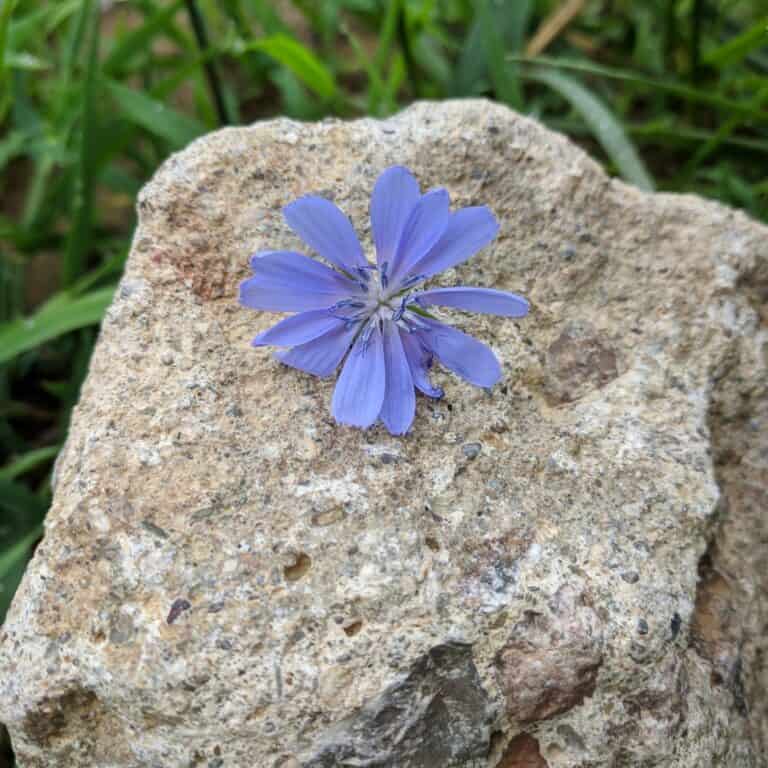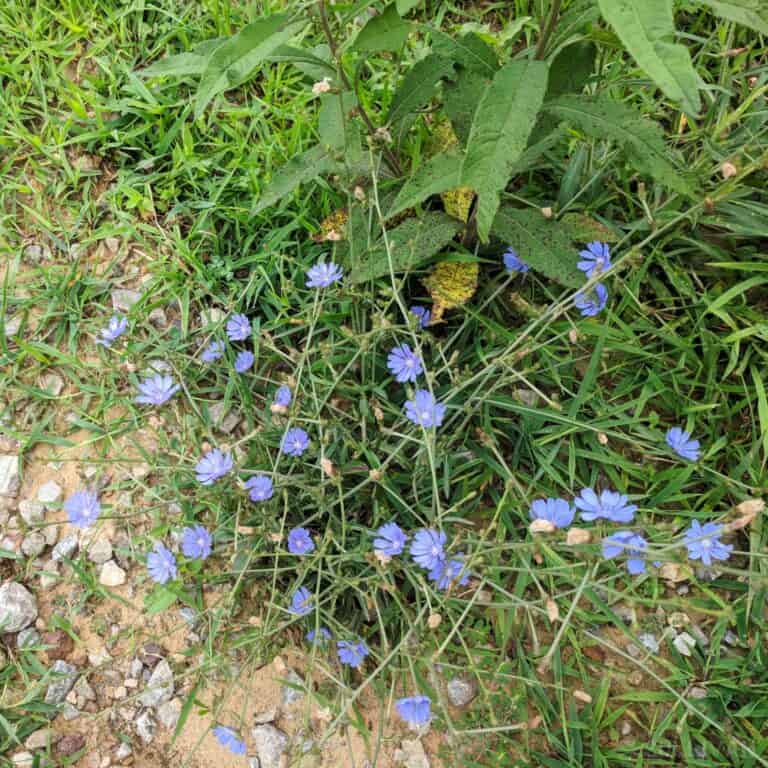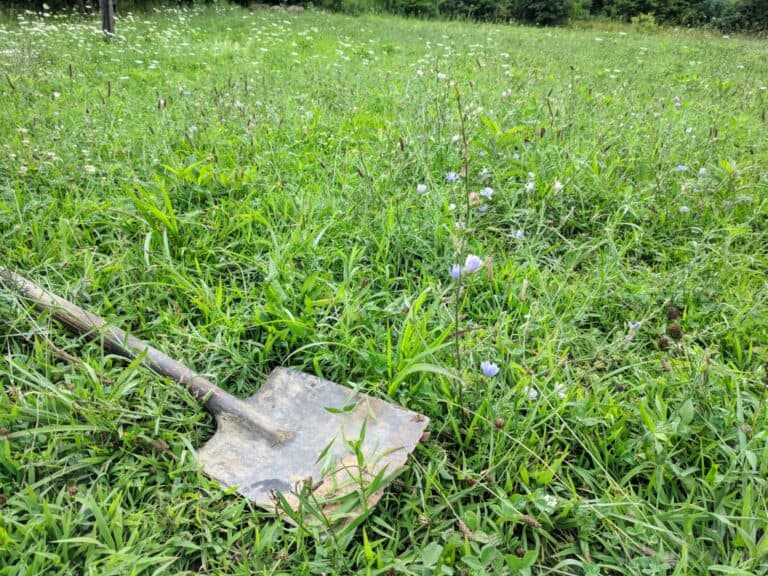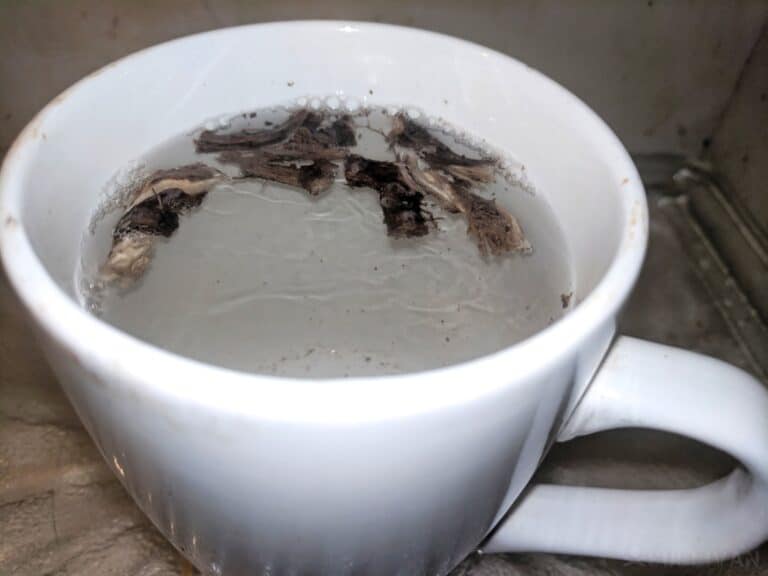Chicory has been used for both medicinal and edible purposes for more than 5,000 years. Not only does chicory taste delicious as coffee and jelly, it can help heal and prevent a plethora of health problems.
The wild chicory plant typically boasts a blue to purple flower, but the petals can be either white or pink. Chicory is a perfect plant for wildcrafting, especially for beginning foragers because it looks exactly as described in guidebooks and has zero poisonous lookalikes.

Table of Contents
Chicory Medicinal Properties
The list of health benefits is a long one, and more can be added.
- Extract from chicory plant root is believed to possess anti-inflammatory, antibacterial, and sedative properties.
- Nursing mothers have consumed the milky sap from chicory plants to help increase their milk flow – or to reduce it when too much milk is being produced. However, this use can be hotly debated, with some folks recommending against using chicory when nursing.
- The flowers from the plant have been used to help alleviate inflamed eyes.
- Crunching up or “bruising” leaves from a chicory plant have been used to rub directly onto a swollen area of the body, or in poultices created to treat the same condition.
- The wild plant may also be helpful in treating liver and gallstone problems. But, some folks have warned that taking chicory when gallstones are already present could make the problem worse due to a possible increase in bile movement.
- Root extract may also help lower blood sugar levels, and weaken the pulse.
- Leaf extract could possess the same properties as noted just above, but likely do so to a lesser degree.
- The plant could help prevent or delay diabetes.
- Bowel movements could be improved by the consumption of chicory root extract.
- Consumption of chicory root could help reduce knee, hip, join, and arthritis stiffness – and pain.
- Chicory has been shown to improve renal function in rats with renal injury. (source)
- It can also help positively influence hyperglycemia and bowl movement. (source)
- Oligofructose derived from the inulin like the type found in chicory root could reduce the “hunger hormone” known as ghrelin – therefore reducing the appetite and helping in a weight reduction plan.
- Root extract may also be helpful in treating jaundice.
- The Studies on Industrial Importance and Medicinal Value of Chicory Plant report indicates chicory could be beneficial in fighting heart disease and digestive problems.
- One of the many digestive woes chicory can help curtail is acid reflux.
- The inulin in chicory plants also harnesses it prebiotic compounds to help promote the growth of good gut bacteria. Chicory is believed to help facilitate the growth of bifidobacteria in particular, a good bacteria that is most often consumed from cheese or yogurt.
- Chicory might reduce LDL cholesterol levels in the body due to its inulin composition.
- The body’s immunity system may also be bolstered by the consumption of chicory. The phytochemicals in the healing plant may behave as antioxidants can help remove free radicals from the bloodstream.
- Chicory root extract’s natural sedative properties may reduce anxiety and – or allow it to be used as a sleep aid.
- The wild weed can help increase urine volume, and allow root consumption to be used as a natural diuretic, while possibly improving overall kidney health.
Chicory Side Effects
- When consumed or even possibly used topically by pregnant women, chicory root could provoke menstrual bleeding and possibly a miscarriage.
- Topical use could cause dermatitis in some users.
- If you are allergic to marigolds, ragweed, or daisies, there is a good chance that you will have the same type of a reaction to chicory, as well.
As usual, the scientific studies on natural medicine alternatives are few and far between. The studies focused on chicory are most often specific to the root and consuming the healing “weed” via a coffee or tea.
Disclaimer
I am not a medical professional of any type. The information about the possible healing properties of chicory presented in this article are purely for educational and research purposes. Always speak with your doctor before using any natural or alternative remedy.
Chicory Plant History
The chicory plant hails from the Mediterranean. It was widely distributed around the globe as a salad green.
The Romans fully grasped the uses of chicory as both a culinary herb and a medicinal one, as well. The plants the Romans cultivated were far more robust than the wild plants we now often see dotting the landscape along roadways as we pass by.
Beginning in the 1700s through around 1950s chicory was frequently cultivated on farms and homesteads throughout North America.
The easy to grow plant became naturalized to our climate, “escaped” cultivation boundaries and started to grow wildly from the southern border of Canada across the United States.
During our colonial days, chicory was cultivated in gardens across our developing country as a medicinal herb. President Thomas Jefferson, an avid gardener, grew chicory as a forage crop.
The wild plant can sometimes be a little taxing to dry, so pioneers and early homesteaders often cut it up and fed it to their rabbits, horses, poultry birds, sheep, and cattle as a healing feed supplement.
Chicory as a Culinary Herb and Wild Edible
Like roasted malt and pine needs, chicory has been used in a plethora of baking recipes to produce a more robust flavor. Chicory can intensify the flavor or sugar (especially if you use stevia as a substitute for conventional sugar) at least 100 fold.
Chicory has also been used as a coffee substitute or coffee flavoring for hundreds to thousands of years. I am not a coffee drinker, but one time when I was in New Orleans enjoying a delicious beignet at Cafe Du Monde, the incredible scent of the coffee others were drinking tempted me to try a cup.
Wow. I am not sure what regular coffee tastes like, but the chicory enhanced cup was absolutely delicious. No wonder one of the many things NOLA is famous for is its coffee.
Chicory roots are high in inulin – a natural prebiotic and sweetener compound. The plant itself also containers coumarins and flavonoids that can help fight various diseases. They can also be eaten raw, boiled, or ground up into a powder after they are dried and used as a seasoning.
The USDA National Nutrient Database reveals that chicory is a superb source of calcium, vitamins A, B6, C, E, K, manganese, zinc, sodium, folic acid, iron, and potassium.
In Europe, chicory is still regularly used as a salad green and not considered a lowly weed at all. In Italy, the leaves of the plant are sold in markets as radicchio.
The French force chicory roots to sprout as the plant is deprived of any light to alter their shape and make Belgian endive. They also use chicory greens in many recipes and call them whitloof.
Chicory greens are also delicious when sauteed with onions and garlic. Young leaves are great when tossed raw into salads or cooked once mature. The flowers are somewhat bitter, but edible alone. When the flowers are mixed into a jelly, the mixture of sweet and bitter makes your mouth water in anticipation.
Chicory Craft Uses
The flowers from the chicory plant can be used to make a natural yellow dye. Leaves from this beneficial weed made a beautiful blue dye for fabric or wool.

How to Identify Chicory
- Chicory, a perennial, reproduces via a scattering of its seeds.
- The plant grows first as a rosette and only later in the season churns out its sturdy and leafless stem. The bottom portion of the stem is hairy.
- Chicory flowers bloom from July through October in most climates.
- The plant resembles a dandelion in relation to both its deep taproot, and to the toothed basal leaves in a rosette shape.
- Unlike dandelions, chicory stalks have only small leaves that are sparsely distributed.
- Young chicory plant leaves are fairly egg shaped, are a bit shiny in texture, and a shade of pale green.
- The stalk of a chicory plant is both hairy and stiff.
- Chicory plant stalks typically range in size from 2 to 5 feet tall and, boast several thin branches.
- The stalks are only about 1 1/2 inches wide before the flower head forms.
- The axils of the stem develop leaves about the middle of summer.
- Flowers are blue to purple generally, but can also be produced in shade or either white or pink.
- The taproot of the plant houses an extremely bitter and milky liquid that is commonly referred to as juice.
- The flowers open and close on the plants daily. Depending upon your climate, they open around 5 a.m., but are closed up again by mid-morning or noon. On cloudy days, the flowers tend to stay open longer. Only a few flowers on each plant open every day.
- Ground leaves on the plant are about three to 6 inches long.
- The small leaves that alternate on the sides of the stem are typically 1/2 to 1 inch tall.
- The flowers are approximately 1.5 inches in diameter, and can hold as many as 20 petals on a single head.
- Each flower petal is fringed, kind of like the end of a scarf, on the broad end.
- Chicory flowers do not have much of a scent. Some folks say that the flowers “smell like a barnyard.” Perhaps that is because they grow in great abundance in livestock pastures, and are a favorite treat to most varieties of commonly kept farm animals.
- Seeds of chicory plants are flat and oblong, and measure approximately 1/4 of an inch long.
- Wild chicory has a significantly more thin root than domesticated or cultivated versions.
- On average, each chicory plant is capable of producing approximately 3,000 seeds.
Where Does Chicory Grow?
This healing and edible plant is not picky about the soil it calls home. Even though the flower petals shy away from sunshine, it almost always can be found growing in full sun areas.
The long taproot on a chicory plant allows it to grow in some pretty rocky, clay, or generally tough dirt. The plant thrives in lime rich soil. Soil with a pH balance of 5.8 to 6.5 is optimal.

When And How To Harvest Chicory
It is best to harvest chicory roots and stems in the spring or fall. The summer heat can make these parts of the plant far more bitter.
The young spring leaves on the chicory plant are a whole lot less bitter than mature leaves, especially when eaten raw.
Harvesting of the flowers is conducted during the summer to early fall months – since that is the only time they are in bloom.
Seeds are typically harvested at the end of summer or into the very early fall before they are spread naturally or lost to colder weather and wind. If you are saving chicory seeds to plant, start them any time from the very end of March through the middle of May.
Use a hand gardening shovel or a trowel to dig several inches around the outside of the plant stems to urge the root out of the ground. Be careful not to bruise or nick the root with the gardening tool.
The digging could take a while depending upon the size of the plant. Some chicory taproots can grow as deep as two feet under the ground.
Preservation
- There will be 5 – 7 inches of crowns around the tapered taproot. Each portion of the root could be as long as 10 inches. Snip the root tops about 2 inches below the plant stem to free them.
- The roots should be stored in a humid area with a temperature of about 40F (4C). The roots can usually be stored in this manner for about 90 days.
- Always scrub down the roots with a firm-bristled brush, and then wash them in cold to lukewarm water.
- Chop the roots into small chunks using a shary and heavy knife or grind them up, before either roasting or brewing them.
- Chicory leaves should be washed at least twice under running water to remove all debris. Then, put them in a strainer before laying them out on a towel to dry further.
- Freezing is not recommended for chicory leaves and stems due to flavor or potency loss. Instead, dehydrate and/or powder them to make them more shelf-stable. The leaves can also be stored in an airtight container in the refrigerator for up to 10 days.
- The entire chicory plant can be hung to air dry just as you would do with garden herbs and wildflowers. They must be hung in a location that is not damp, is not in direct sunlight, and is well ventilated.
- To harvest seeds from a chicory plant, gather them in small clusters from in-between leaf bunches. Use tweezers to scoop away the seed pods.
Root Preparation and Coffee Making
Exactly why chicory began being used to make coffee or supplement a warm cup, remains a bit unclear. But, the practice is believed to have started in France during the 1800s when a coffee shortage occurred.
In a desperate attempt to fill their mugs with something coffee-like, folks in France began roasting the taproot of a chicory plant and mixing it into their cups – with or without conventional coffee.
Several decades later during the Civil War, chicory once again emerged as a coffee alternative when the Union Army set up blockades to cut the South, New Orleans in particular, off from supply ships – hence another coffee shortage.

Today, some coffee lovers attempting to give up or reduce caffeine intake, a bringing chicory coffee back to popularity.
Prepare chicory roots to brew into coffee or a tea by roasting them on a baking sheet in the oven at a temperature no greater than 170 degrees for five to seven hours. Cut the roots as finely as possible so they dry quickly and no pockets of moisture that could draw bacteria are present inside the thick roots.
Chicory root is more soluble than coffee beans, so it will take far less water to brew them.
- Use ½ of a teaspoon of chicory root for each cup of coffee you are brewing.
- If mixing chicory in with coffee or a tea, use approximately two-thirds of tea or coffee to ever one-third of chicory root used.
- Brew your coffee or tea as you normally would.
- Cloves, nutmeg, and cinnamon are often added to chicory coffee to give it a more pleasing taste, and to garner the healing properties from the spices.
How to Make Chicory Poultice
Do not let herbal poultice making intimidate you. The process can be as simple as laying a leaf, flower, or powdered root on an injured area and holding it in place with a bandage.
A poultice is merely a means of getting healing herbs in direct contact with the skin. Herbs being used are crushed up into small bits and turned into a pulp (or paste) using a carrier oil. Common carrier oils include: olive oil, coconut oil, vegetable glycerin, jojoba oil, arnica oil, and almond oil.
Just combine only enough of the chosen carrier oil with the herbs to make a paste thick enough not to slide off of the skin. Usually, the recommended herb to oil ratio is 2 to 1.
Next, wrap gauze or a clean piece of cotton over the herbal paste and around the injured area to keep the mixture in place.
Warming the poultice paste to alter its natural temperature can foster greater healing and pain reduction. For example, a cold poultice can help reduce swelling, but a warm poultice can help draw out infection and increase circulation around the wound area.
A poultice typically helps the herbs be better absorbed into the skin than a cream or salve.
Foraging for chicory may be one of the easiest wildcrafting or survival medicine activities you will ever do. Finding the healing plant does not require rugged hiking and the possibility of mistaking chicory for a toxic look-alike (which is a worry with healing plants like yarrow and wild carrots) is beyond slim.


Tara Dodrill is a homesteading and survival journalist and author. She lives on a small ranch with her family in Appalachia. She has been both a host and frequent guest on preparedness radio shows. In addition to the publication of her first book, ‘Power Grid Down: How to Prepare, Survive, and Thrive after the Lights go Out’, Dodrill also travels to offer prepping tips and hands-on training and survival camps and expos.

Since Chicory grows anywhere, I would also add that if you are harvesting chicory along the road side be aware that they can contain toxins from car exhaust, road salt, and depending on where you live, sprayed with weed killers like RoundUp from surrounding crop fields, either as a direct spraying of the road side or by over spray when farmers are spraying the field.
I think growing it in a safe spot would be an awesome way to add this lovely little medicinal to the garden edging, or a waste space where you can’t plant anything else and you can protect it from harmful chemicals.